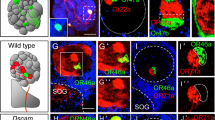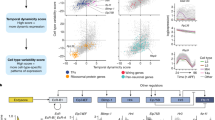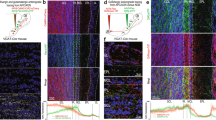Abstract
From insects to mammals, olfactory receptor neurons (ORNs) expressing a common olfactory receptor target their axons to specific glomeruli with high precision. Here we show in Drosophila that the POU transcription factor Acj6 controls the axon targeting specificity of a subset of ORN classes, as defined by the olfactory receptors that they express. Of these classes, some require Acj6 cell-autonomously, whereas others require Acj6 cell-nonautonomously. Mosaic analyses show that cooperative targeting occurs between axon terminals of the same ORN classes and that there are hierarchical interactions among different ORN classes. We propose that the precision of ORN axon targeting derives from both intrinsic transcriptional control and extensive axon-axon interactions.
This is a preview of subscription content, access via your institution
Access options
Subscribe to this journal
Receive 12 print issues and online access
$209.00 per year
only $17.42 per issue
Buy this article
- Purchase on Springer Link
- Instant access to full article PDF
Prices may be subject to local taxes which are calculated during checkout






Similar content being viewed by others
References
Clyne, P.J. et al. A novel family of divergent seven-transmembrane proteins: candidate odorant receptors in Drosophila. Neuron 22, 327–338 (1999).
Vosshall, L.B., Amrein, H., Morozov, P.S., Rzhetsky, A. & Axel, R. A spatial map of olfactory receptor expression in the Drosophila antenna. Cell 96, 725–736 (1999).
Vosshall, L.B., Wong, A.M. & Axel, R. An olfactory sensory map in the fly brain. Cell 102, 147–159 (2000).
Gao, Q., Yuan, B. & Chess, A. Convergent projections of Drosophila olfactory neurons to specific glomeruli in the antennal lobe. Nat. Neurosci. 3, 780–785 (2000).
Dobritsa, A.A., van der Goes van Naters, W., Warr, C.G., Steinbrecht, R.A. & Carlson, J.R. Integrating the molecular and cellular basis of odor coding in the Drosophila antenna. Neuron 37, 827–841 (2003).
Jefferis, G.S.X.E., Marin, E.C., Stocker, R.F. & Luo, L. Target neuron prespecification in the olfactory map of Drosophila. Nature 414, 204–208 (2001).
Marin, E.C., Jefferis, G.S.X.E., Komiyama, T., Zhu, H. & Luo, L. Representation of the glomerular olfactory map in the Drosophila brain. Cell 109, 243–255 (2002).
Wong, A.M., Wang, J.W. & Axel, R. Spatial representation of the glomerular map in the Drosophila protocerebrum. Cell 109, 229–241 (2002).
Vassar, R. et al. Topographic organization of sensory projections to the olfactory bulb. Cell 79, 981–991 (1994).
Ressler, K.J., Sullivan, S.L. & Buck, L.B. Information coding in the olfactory system: evidence for a stereotyped and highly organized epitope map in the olfactory bulb. Cell 79, 1245–1255 (1994).
Mombaerts, P. et al. Visualizing an olfactory sensory map. Cell 87, 675–686 (1996).
Zou, Z., Horowitz, L.F., Montmayeur, J.P., Snapper, S. & Buck, L.B. Genetic tracing reveals a stereotyped sensory map in the olfactory cortex. Nature 414, 173–179 (2001).
Wang, F., Nemes, A., Mendelsohn, M. & Axel, R. Odorant receptors govern the formation of a precise topographic map. Cell 93, 47–60 (1998).
Wang, J.W., Wong, A.M., Flores, J., Vosshall, L.B. & Axel, R. Two-photon calcium imaging reveals an odor-evoked map of activity in the fly brain. Cell 112, 271–282 (2003).
Ang, L.H., Kim, J., Stepensky, V. & Hing, H. Dock and Pak regulate olfactory axon pathfinding in Drosophila. Development 130, 1307–1316 (2003).
Hummel, T. et al. Axonal targeting of olfactory receptor neurons in Drosophila is controlled by Dscam. Neuron 37, 221–231 (2003).
Hummel, T. & Zipursky, S.L. Afferent induction of olfactory glomeruli requires N-cadherin. Neuron 42, 77–88 (2004).
Jhaveri, D., Saharan, S., Sen, A. & Rodrigues, V. Positioning sensory terminals in the olfactory lobe of Drosophila by Robo signaling. Development 131, 1903–1912 (2004).
Komiyama, T., Johnson, W.A., Luo, L. & Jefferis, G.S.X.E. From lineage to wiring specificity. POU domain transcription factors control precise connections of Drosophila olfactory projection neurons. Cell 112, 157–167 (2003).
Clyne, P.J. et al. The odor specificities of a subset of olfactory receptor neurons are governed by Acj6, a POU-domain transcription factor. Neuron 22, 339–347 (1999).
Ayer, R.K., Jr. & Carlson, J. acj6: a gene affecting olfactory physiology and behavior in Drosophila. Proc. Natl. Acad. Sci. USA 88, 5467–5471 (1991).
Estes, P.S., Ho, G.L., Narayanan, R. & Ramaswami, M. Synaptic localization and restricted diffusion of a Drosophila neuronal synaptobrevin–green fluorescent protein chimera in vivo. J. Neurogenet. 13, 233–255 (2000).
Lee, T. & Luo, L. Mosaic analysis with a repressible cell marker for studies of gene function in neuronal morphogenesis. Neuron 22, 451–461 (1999).
Newsome, T.P., Asling, B. & Dickson, B.J. Analysis of Drosophila photoreceptor axon guidance in eye-specific mosaics. Development 127, 851–860 (2000).
Arber, S., Ladle, D.R., Lin, J.H., Frank, E. & Jessell, T.M. ETS gene Er81 controls the formation of functional connections between group Ia sensory afferents and motor neurons. Cell 101, 485–498 (2000).
Lin, J.H. et al. Functionally related motor neuron pool and muscle sensory afferent subtypes defined by coordinate ETS gene expression. Cell 95, 393–407 (1998).
Jefferis, G.S.X.E. et al. Developmental origin of wiring specificity in the olfactory system of Drosophila. Development 131, 117–130 (2004).
Zhu, H. & Luo, L. Diverse functions of N-cadherin in dendritic and axonal terminal arborization of olfactory projection neurons. Neuron 42, 63–75 (2004).
Ebrahimi, F.A. & Chess, A. Olfactory neurons are interdependent in maintaining axonal projections. Curr. Biol. 10, 219–222 (2000).
Vassalli, A., Rothman, A., Feinstein, P., Zapotocky, M. & Mombaerts, P. Minigenes impart odorant receptor-specific axon guidance in the olfactory bulb. Neuron 35, 681–696 (2002).
Feinstein, P. & Mombaerts, P. A contextual model for axonal sorting into glomeruli in the mouse olfactory system. Cell 117, 817–831 (2004).
Clandinin, T.R. & Zipursky, S.L. Afferent growth cone interactions control synaptic specificity in the Drosophila visual system. Neuron 28, 427–436 (2000).
Wang, J., Zugates, C.T., Liang, I.H., Lee, C.H. & Lee, T. Drosophila Dscam is required for divergent segregation of sister branches and suppresses ectopic bifurcation of axons. Neuron 33, 559–571 (2002).
Ng, J. et al. Rac GTPases control axon growth, guidance and branching. Nature 416, 442–447 (2002).
Scott, K. et al. A chemosensory gene family encoding candidate gustatory and olfactory receptors in Drosophila. Cell 14, 661–673 (2001).
Acknowledgements
We thank L. Vosshall, K. Scott, C. Warr, A. Goldman, C. Miller, D. Lessing, A. Ray and R. Ignell for the OR-Gal4 drivers; E. Buchner for antibodies; and T. Clandinin, K. Shen and members of the Luo laboratory for comments on the manuscript. This work was supported by grants from the US National Institutes of Health (to L.L. and J.R.C.).
Author information
Authors and Affiliations
Corresponding author
Ethics declarations
Competing interests
The authors declare no competing financial interests.
Supplementary information
Supplementary Fig. 1
Drifter is not expressed in most developing ORNs. (a, b, c) Drifter is not expressed in the developing 3rd antennal segment (outlined in a3-c3) at 18 (a), 24 (b) and 50 (c) hour APF. (d, e) At both 50 (d) and 72 (e) hour APF, Drifter is expressed in the developing maxillary palp (outlined in d3 and e3), but mostly in Elav-negative cells. (JPG 155 kb)
Supplementary Fig. 2
Normal targeting of ipsi- and contralateral targeting of Or47b and 88a axons in acj6 heterozygous control and hemizygous mutant. The right antenna was excised and brains were dissected 10 days later. (JPG 119 kb)
Supplementary Fig. 3
Mistargeting studied using a presynaptic marker n-syb-GFP. Targeting defects of acj6 hemizygous mutants revealed by n-syb-GFP are similar to those observed using a membrane marker mCD8-GFP (Figs. 4&5). (JPG 79 kb)
Supplementary Fig. 4
ORN axons of the same class do not show extensive fasciculation prior to glomerular targeting. Arrows indicate non-fasciculated axons. (JPG 176 kb)
Rights and permissions
About this article
Cite this article
Komiyama, T., Carlson, J. & Luo, L. Olfactory receptor neuron axon targeting: intrinsic transcriptional control and hierarchical interactions. Nat Neurosci 7, 819–825 (2004). https://doi.org/10.1038/nn1284
Received:
Accepted:
Published:
Issue Date:
DOI: https://doi.org/10.1038/nn1284
This article is cited by
-
Inter-axonal recognition organizes Drosophila olfactory map formation
Scientific Reports (2019)
-
Linking neuronal lineage and wiring specificity
Neural Development (2018)
-
Olfactory sensory axons target specific protoglomeruli in the olfactory bulb of zebrafish
Neural Development (2017)
-
Mechanisms controlling diversification of olfactory sensory neuron classes
Cellular and Molecular Life Sciences (2017)
-
Chitosan/siRNA nanoparticle targeting demonstrates a requirement for single-minded during larval and pupal olfactory system development of the vector mosquito Aedes aegypti
BMC Developmental Biology (2014)



